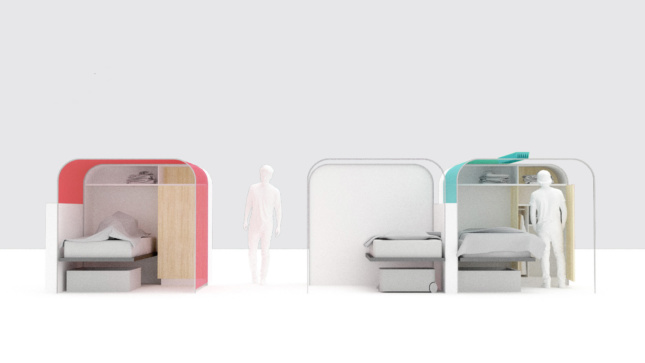The Los Angeles office of Perkins and Will has set their sights on the smallest imaginable scale for a modular sleeping unit built for the city’s growing homeless population. In response to the mayor’s A Bridge Home initiative, a city-led project focusing on creating transitional emergency shelters, the firm’s Innovation Incubator team designed the prefabricated Dome unit in an effort to offer a higher level of dignity and sophistication than typically found in U.S. shelters.
“We want it to feel residential, not institutional,” said Yan Krymsky, a design director at Perkins and Will, in a statement. “It sends a message that people care.”

Each Dome unit is seven feet wide and six feet deep to provide 42 square feet of space per person. It features a lockable wardrobe, a standard power outlet, a frame for a twin bed, an optional kennel area for a 30-pound pet, and an operable canvas tarp for privacy. Designed with low-cost, quality materials that make each unit feel like a temporary little home, the firm estimates that individually, they could cost as little as $4,749 to build. Locker fabrication company Shield has already been tapped to manufacture them.
“Solid surface is low maintenance and resists scratching,” the team said, “while wood accents give the unit a residential character.”
If desired, the units can be combined to allow couples or families to share a larger set together.

According to Perkins and Will, the most challenging part of the Dome project was making the units feel dignified and structured when in use while at the same time, flexible enough to collapse for storage and redeployment across the city. A typical 53-foot-long flatbed truck, for instance, can carry up to 32 units when collapsed.
A number of other Los Angeles-based firms have developed concepts for homeless housing alternatives, such as Brooks + Scarpa and Michael Maltzan Architecture, and several shelters have already been completed through the A Bridge Home program. As the city with the largest number of homeless residents in the United States, The Dome units present a potentially more expedient option for emergency shelter than other temporary housing structures currently proposed for the city.
A prototype of a Dome unit is currently on display at the Architecture + Design Museum (A+D) in Los Angeles until January 12.











